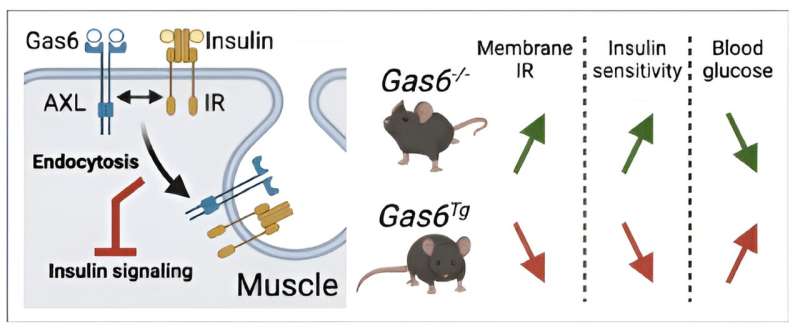This article has been reviewed according to Science X's editorial process and policies. Editors have highlighted the following attributes while ensuring the content's credibility:
fact-checked
peer-reviewed publication
trusted source
proofread
Findings shed light on the cellular mechanisms causing insulin resistance

Recent research published in the journal Diabetes sheds new light on the cellular mechanisms causing insulin resistance in type 2 diabetes, a disease affecting more than 1.2 million people in Quebec alone.
Type 2 diabetes is a complex condition for which there is no cure yet, making it a chronic condition. It is characterized by a reduction in the ability of cells to respond to insulin. This is known as insulin resistance. The cellular mechanisms causing insulin resistance are far from fully understood, but the Ferron laboratory is committed to advancing knowledge on this front.
Insulin is a hormone that controls glucose (sugar) levels in the blood. It acts by binding to its receptor, the insulin receptor, present on the surface of cells in several organs such as muscles, adipose tissue and liver.
The research comes from the laboratory of Mathieu Ferron, Associate Professor in the Department of Medicine at the Université de Montréal and Director of the Molecular Physiology Research Unit at the Montreal Clinical Research Institute (IRCM).
In this study, Dr. Ferron's laboratory focused on a protein called GAS6, which is vitamin K-dependent. Previous studies had suggested that in humans, circulating levels of GAS6 were positively associated with insulin resistance and type 2 diabetes. However, the mechanism by which GAS6 might cause insulin resistance and type 2 diabetes remains unknown.
The team was able to demonstrate that the absence of GAS6 in mouse models prevented insulin resistance caused by a high-fat, high-sugar diet. Conversely, when GAS6 levels in the blood were artificially increased, the team observed insulin resistance.
This is the first time that this signaling pathway (GAS6 and AXL) has been directly implicated in insulin resistance. This work also suggests that GAS6 or its receptor AXL could be therapeutic targets for the treatment of insulin resistance.
Like insulin, GAS6 acts on cells via a receptor called AXL. This work shows that AXL is not only present in muscle cells but can also bind to the insulin receptor in these same cells. What's more, when GAS6 binds to its receptor on muscle cells, they no longer respond to insulin in the same way. It's as if GAS6 and AXL were "reprogramming" the insulin response.
In fact, it seems that GAS6, by binding to AXL on the cell surface, draws the insulin receptor into a compartment called the endosome (which acts as a sort of recycling bin for the cell), diminishing the cell's ability to respond to insulin.
Dr. Ferron's team intends to test the effect of molecules that can block AXL activation by GAS6 in diabetic mouse models. This could lead to a new approach to the treatment of type 2 diabetes.
More information: Céline Schott et al, GAS6 and AXL promote insulin resistance by rewiring insulin signaling and increasing insulin receptor trafficking to endosomes, Diabetes (2024). DOI: 10.2337/db23-0802





















